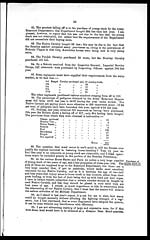Medicine - Veterinary > Civil Veterinary Departments > Annual administration report of the Civil Veterinary Department of India > 1896-1897 > Part I - Imperial report
(34) Page 16
Download files
Individual page:
Thumbnail gallery: Grid view | List view

16
and this would render supervision a matter of great difficulty. Without super-
vision no run can possibly prove a success, and therefore I propose that these
runs should exist at every station where a Native Cavalry is quartered, and
that they should be connected with the Grass Farms. If this could be arranged,
all young stock with a Regiment could then be moved from run to run when
one Regiment marches in relief of another. The only expense connected with
the scheme would be the fencing of the paddocks, which, however, need not be
of an expensive character, and frequently it is possible to find a site that would
have natural boundaries on one or two sides; this is the only direction in which
I can possibly see that Regiments might want assistance at the onset; the
advantages are, however, so great that I feel they would outweigh any dis-
advantages that might be brought forward against the scheme.
92. I have already stated that the system has been tried on a small scale
by some Regiments, including the 6th Bengal Cavalry, 14th and 18th Bengal
Lancers, and Queen's Own Corps of Guides. Wishing to obtain as much inform-
ation on this subject as possible, I addressed the various Commanding Officers
and the following resume will give their views on the subject. I might add
that I am authorized by these officers to utilize the statements made by
them.
93. I purpose commencing with the run of the Queen's Own Corps of
Guides, as it was also referred to in last year's Administration Report of this
Department. Colonel Egerton states:—
"There are now on the run 55 colts and fillies ranging from one year to four years of age, the great majority
being by Government stallions, but there are a few whose parentage is unknown."
Amongst the sires enumerated, are:—
10 Thoroughbred English.
6 Norfolk Trotters or Hackneys.
2 Arabs.
Colonel Egerton then proceeds to state:—
"During the year 22 have been passed into the ranks, and there are 11 four-year olds now about to be
taken into the ranks where they will do light work until they are five years old.
"As regards quality, there is no comparison between the Rukh colts and fillies and those bought at Fairs.
The way they develop on the run is astonishing, and their great docility makes them far easier to break in than
animals bought at Fairs, who for the most part have been moored fore and aft for the last two years of their
existence, and whose development has been checked. I think, so far as we have got, our run has been an
unqualified success."
94. Next in importance is the run of the 14th Bengal Lancers at Saugor.
Here, the Regiment has two paddocks, one for colts and one for mares, the
former measuring 140 × 110 yards, the latter 195 × 120.
95. This run has only been started for two years and already 92 horses
have joined the ranks, and 41 are in the Riding School, whilst there are 47
head of young stock in the runs. Of these, at least 20 will be old enough to
send to the Riding School by October next.
96. From the above it will be seen that since the run was started, 180
horses have been on it and only 2 have died, which is very encouraging.
97. Major Peyton has very kindly furnished me with a Memorandum on
the subject by Captain Weller, who virtually started the run, and I feel I
cannot do better than make the following quotations from it:—
"We can buy three-year olds which instead of being tied up in the lines and irregularly exercised and fed
and so failing to develop, getting contracted feet and bad constitutions as formerly, are now given entire liberty,
with the result that they grow and thicken out, get beautiful feet and legs, get over the bad effects of the dealer
or breeder and become strong, hardy, and good constitutioned horses, able to stand work and hard treatment.
Another excellent result of the paddock is the effect on the horse's temper. Since the run was started we have
not had a single excitable horse; they break in better, and with less than half the trouble and time than formerly,
and the Adjutant's chief difficulty now is to keep them long enough in the Riding School, as they now start as
quiet tractable horses afraid of nothing. So much is this the case that we have made several of the horses, which
were formerly practically useless, into nice steady good doers, by simply giving them six months' run in the
paddock."
98. The memorandum then goes on to state the various sources from which
profit can be made in order to ensure financial success, but with this I do not
feel it my duty to deal, except to state that the horses do not cost more than if
bought as four-year olds.
99. Captain Weller then proceeds to state:—
''The scheme has now been running for about 15 months (this was in October 1896) and the Native Officers
and Sowars are beginning to see the advantages from their point of view."
Set display mode to: Large image | Zoom image | Transcription
Images and transcriptions on this page, including medium image downloads, may be used under the Creative Commons Attribution 4.0 International Licence unless otherwise stated. ![]()
| India Papers > Medicine - Veterinary > Civil Veterinary Departments > Annual administration report of the Civil Veterinary Department of India > 1896-1897 > Imperial report > (34) Page 16 |
|---|
| Permanent URL | https://digital.nls.uk/75503602 |
|---|




